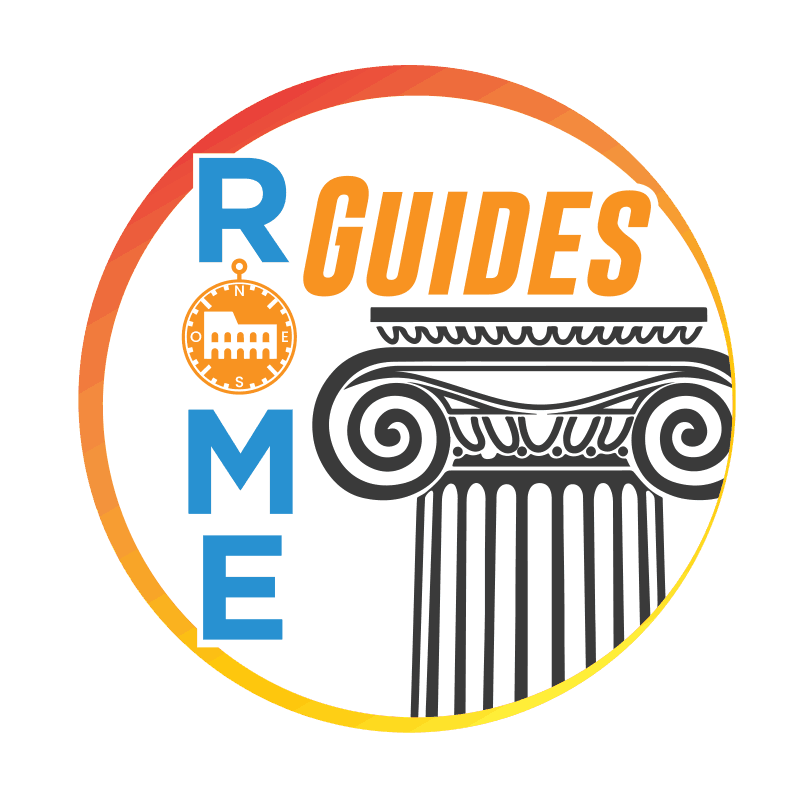ROMAN ITINERARIES – TRASTEVERE DISTRICT – ITINERARY 52
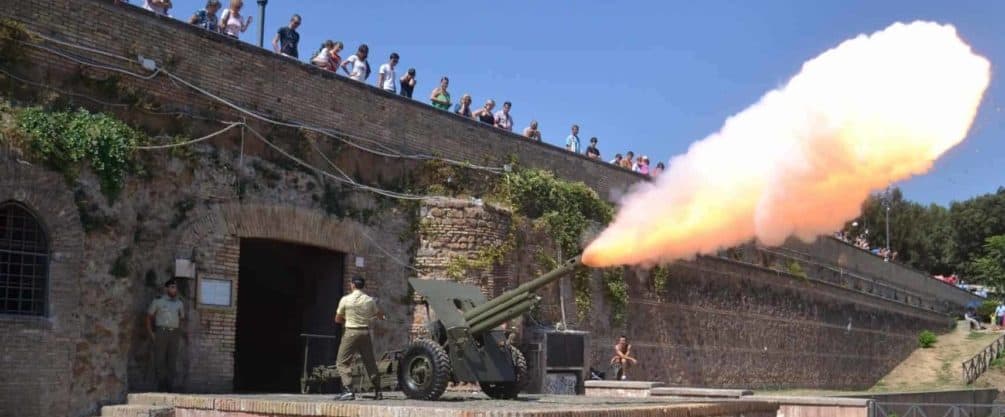
TRASTEVERE DISTRICT – ITINERARY 52
The Itinerary 52 of the Trastevere District ends the exploration of this portion of Rome. From the Settimiana Gate, walk down Via Garibaldi, pass the fountain with the coat of arms of the Barberini family and reach the place which, since the third decade of the 18th Century, was used for the meetings of the Arcadia, the academy founded by Giovan Mario Crescimbeni.
Via Garibaldi – Via di Porta San Pancrazio – Piazza di San Pietro in Montorio – Via Giacomo Medici – Porta San Pancrazio – Passeggiata del Gianicolo – Piazzale Giuseppe Garibaldi – Piazzale Anita Garibaldi – Piazza di Sant’Onofrio – Via del Gianicolo – Salita di Sant’Onofrio
THE PARRASIO WOOD
The Parrasio Wood develops on three different shelves, connected by ramps of steps alternatively concave and convex, placed near the lateral borders of the area and supported by parapets: in the first of them is commemorated the King of Portugal John V, who gave his contribution for the purchase of the place to be given to the Academy, in the second there is a fake cave with a water source in the shade of a giant pine tree, while at the third level there is an elliptical amphitheater with three orders of seats in front of which there is a marble lectern, where poets declaimed their poems in front of the watchful audience. The works and the following restorations were carried out by the architects Antonio Canevari in 1725 (he worked for free, being himself an Arcade), Clemente Orlandi in 1760 and Giovanni Azzurri in 1838.
The entrance of the Parrasio Wood is at number 32 of Via di Porta San Pancrazio: globally, it is a pleasant work of neoclassical taste, which allows you to relive a significant moment in the history of Italian poetry.
THE ARCADES
How were the Arcades born?
After the death of Maria Cristina of Sweden (1689), the poets who frequented her salons in the Corsini Palace continued to meet to recite their verses.
On October 15th 1690, while they were gathered in the garden of the Friars Minor in St. Peter in Montorio, the scholar Agostino Taja, after having listened to some pastoral lyrics, exclaimed: “It seems to me that today we have renewed Arcadia“. Indeed, in the literary world Arcadia had a particular fairy-tale nature, being considered a region of Greece devoted to a quiet pastoral life, alien to luxury, politics and war. So from those words was born the Academy of Arcadia, which wanted to restore Italian poetry by fighting the exaggerations of the 17th Century and seeking simplicity, directness, and stylistic clarity. The members began to call each other “shepherds” and each of them took a name taken from the bucolic tradition. The center of the academy was the Parrasio Wood, and the coat of arms of the Academy became the flute of Pan, the musical instrument of the pagan god.
Illustrious poets and writers belonged to the Arcadian Academy, such as Metastasio, Goldoni, Alfieri and Goethe.
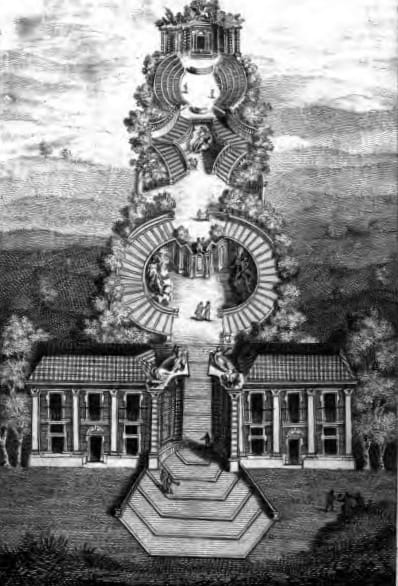
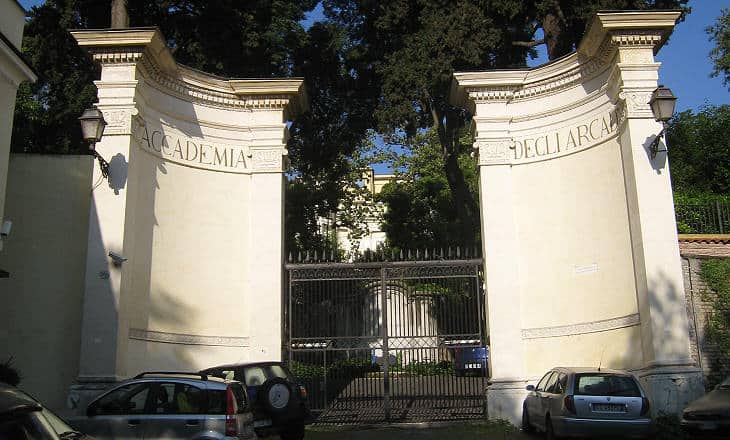
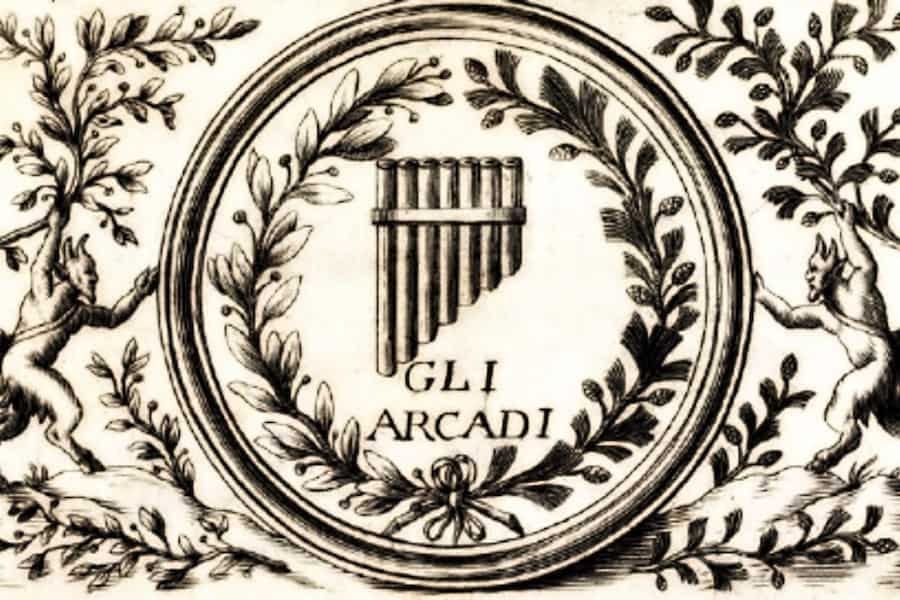
THE CHURCH OF ST. PETER IN MONTORIO
Now continue along Via Garibaldi, until you reach the Square of St. Peter in Montorio.
The square was laid out in 1605 thanks to the economic aid of the King of Spain Philip III; in 1657 it was enriched with a column surmounted by the Cross, in order to delimit the area of the churchyard. The square was also adorned by a 17th Century fountain, nicknamed “the Castilian Fountain“, made at the behest of Philip III with the emblems of the kingdom of Castile: destroyed by French cannons in 1849, it was temporarily replaced by the so-called Fountain of Trullo, later moved to the Nicosia Square (where it is still visible).
The word “Montorio” is most likely a verbal corruption of the expression “monte d’oro” (golden mountain), because of the yellow marl of the Janiculum hill, on which the church stands. In this place, according to the tradition, St. Peter was crucified: his cult existed since the 8th Century, even if the artistic and monumental elements date back to the 15th Century.
Indeed, the church was built at the behest of the Kings of Aragon and Castile Ferdinand and Isabella between 1481 and 1500, where there was an ancient oratory of the 8th Century in ruins. The church is a work attributed to the architects Baccio Pontelli and Meo del Caprino: the latter is considered the author of the Renaissance façade divided into two orders, of which the lower one has a double flight of steps and the upper one a large rose window. Unfortunately, the bombardments occurred during the fights in defense of the Roman Republic in 1849 seriously damaged the church, destroying the 15th Century bell tower (which was then entirely rebuilt), part of the apse and the roof.
THE INTERIOR OF THE CHURCH
Inside, with a single nave and polygonal apse, you can admire important works of art, including the famous Flagellation of Jesus by Sebastiano del Piombo, the Virgin of the Letter by Niccolò Pomarancio and the Coronation of Mary by Baldassarre Peruzzi, all works of the 16th Century. Also noteworthy is the chapel designed by Giorgio Vasari, author of the splendid Conversion of St. Paul, in which Vasari himself has self-portrayed the character dressed in black.
Admire also the Chapel of the Baptism of Jesus, frescoed by Daniele from Volterra, and the baroque Raymondi Chapel, designed by Gian Lorenzo Bernini.
Beatrice Cenci is buried near the high altar: the head of the young girl was kept in a shrine in the church until 1789, when the French soldier Jean Maccuse desecrated the shrine and kicked the unfortunate head of one of the most beautiful women in Rome, then left with the remains of the head in a sack.
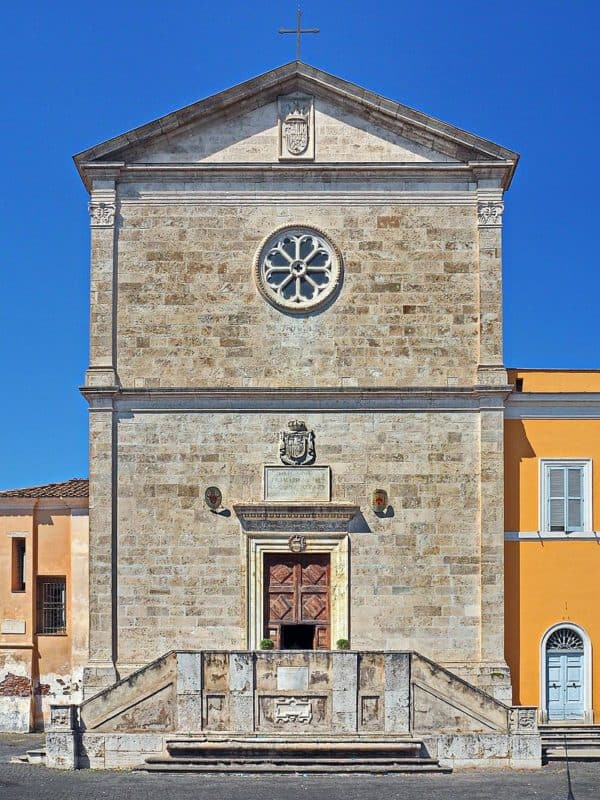
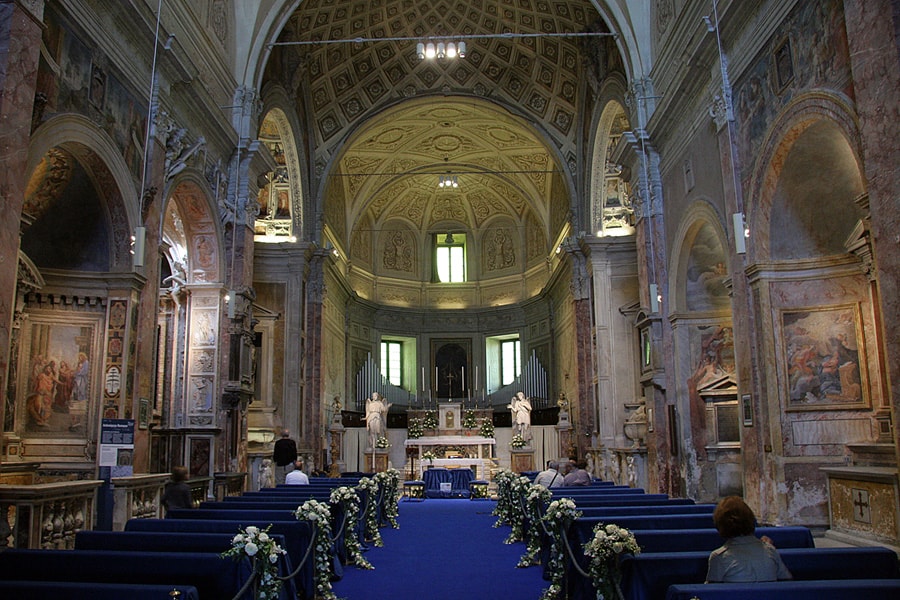
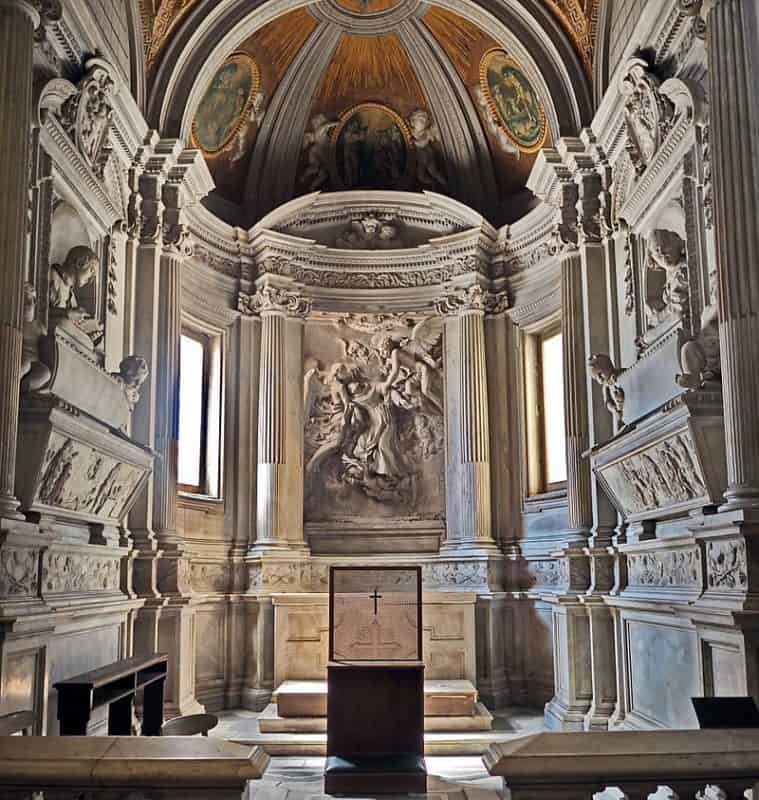
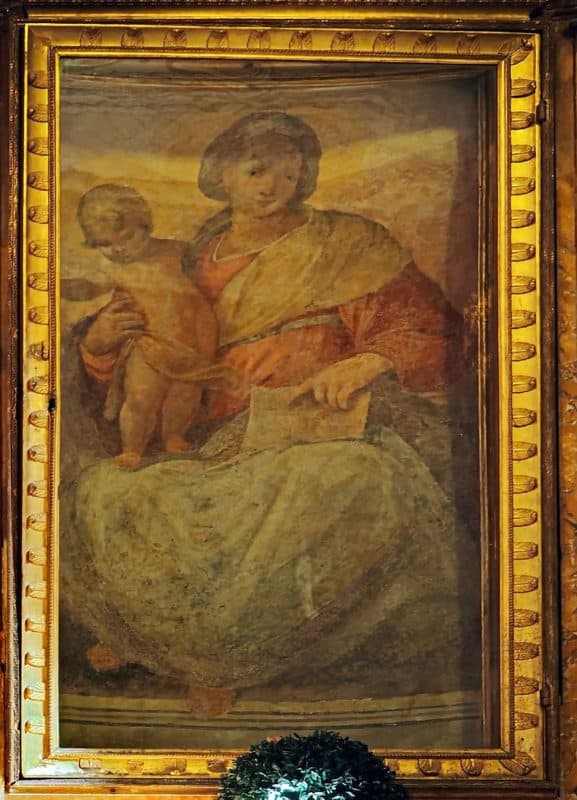
THE BRAMANTE’S TEMPLE
In the cloister of St. Peter in Montorio is one of the most extraordinary jewels of the Italian Renaissance, created by Donato Bramante in 1502 and considered a true masterpiece of proportions: the Bramante’s Temple, a circular plan with Doric columns supporting the entablature with metopes, on which is placed a balustrade that surrounds a dome surrounded by niches. The dome, covered in lead and divided into segments by ribs, ends with a sort of blind lantern, where instead of windows there are various emblems.
Inside you can see a 16th Century statue of St. Peter on the altar and, all around, statues of saints sculpted by Bernini’s pupils. In the underground chapel you can see a hole in which, according to tradition, was stuck the cross of St. Peter, who chose to be crucified upside down for humility towards Christ.
To the side is the building of the Spanish Academy of Fine Arts, resulting from the transformation of the old Franciscan convent, with a beautiful Renaissance cloister.
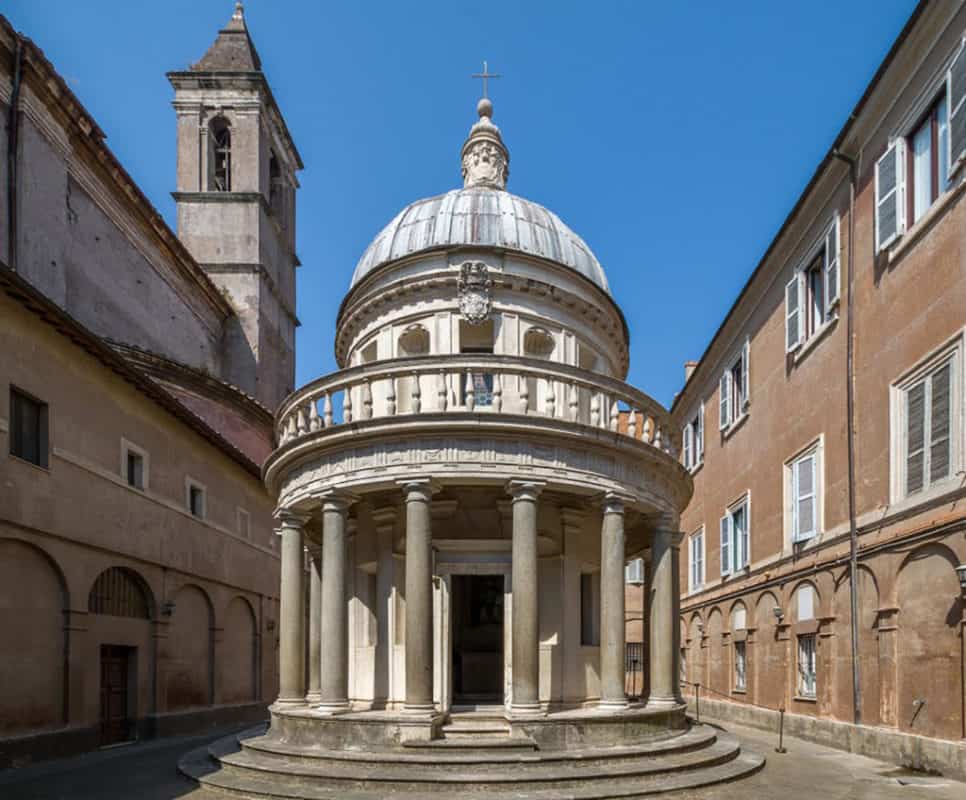
THE MAUSOLEUM OSSUARY JANICOLENSE
Take Via Garibaldi again, paying homage on the left to the Mausoleum Ossuary Janicolense, work of the architect Giovanni Jacobucci (1941), erected in memory of the Fallen Soldiers of 1849, 1867, 1870 and 1943. It has a square plan with three arches on each side, and inside it contains a granite altar with the symbols of Rome and a sarcophagus with the remains of Goffredo Mameli, who died in 1849 and wrote the national hymn of the Italian Republic.
VILLA GIRAUD RUSPOLI
A little further on, you can see the extensive Villa Giraud Ruspoli, built by the architect Romano Carapecchia at the beginning of the 18th Century on commission of the Vaini family, known for having had among its members Guido Vaini, who served as Papal General under Pope Julius II at the beginning of the 16th Century. The villa was heavily restored in the 20th Century, but it still retains its characteristics of high nobility, as in the splendid staircase or in the furniture and tapestries that decorate its rooms. It is currently the residence of the Spanish Ambassador.
THE FOUNTAIN OF THE PAOLA WATER
At this point, you will find yourself in front of the monumental Fountain of the Paola Water, built between 1610 and 1612 by the architect Flaminio Ponzio with the help of the hydraulic engineer Giovanni Fontana, at the behest of Pope Paul V, who wanted to commemorate the restoration of the Aqueduct of Trajan.
The fountain (also called the “Fontanone“, the Big Fountain) and the water took the name of Paola from Pope Paul V, who authorized the architects to recycle the marble used for the construction of the Forum of Nerva. The original project provided that the water was collected in five basins positioned in correspondence of the different arches, but in 1690 Pope Alexander VIII commissioned Carlo Fontana (Giovanni’s nephew) to carry out a project of enlargement of the work. Today the fountain consists of a wide semicircular basin, of a three-arched arch with granite columns on high stilobates, of two minor lateral arches and of an attic with a dedicatory inscription. At the top there are dragons and eagles, elements of the coat of arms of the Borghese family, which appears at the top of the fountain supported by two winged figures, by Ippolito Buzio in 1610.
THE POOR WATER
The Fountain of the Paola Water is also famous for a controversy that arose about the water that fed it. In 1608, indeed, Pope Paul V bought from the Duke of Bracciano Virginio Orsini some springs that, in ancient times, fed the Trajan Aqueduct. The large epigraph in the attic, however, contains an error: it mentions the restoration of the Alsietino Aqueduct while in reality, as mentioned above, it was the ancient Trajan Aqueduct that was restored.
In reality, such an abundance of water was no more than a bitter disappointment for the Roman citizens, who soon realized that the water was not drinkable: for this reason the Romans, when they wanted to depreciate something, used to say that it was “worth as much as the Paola Water“.
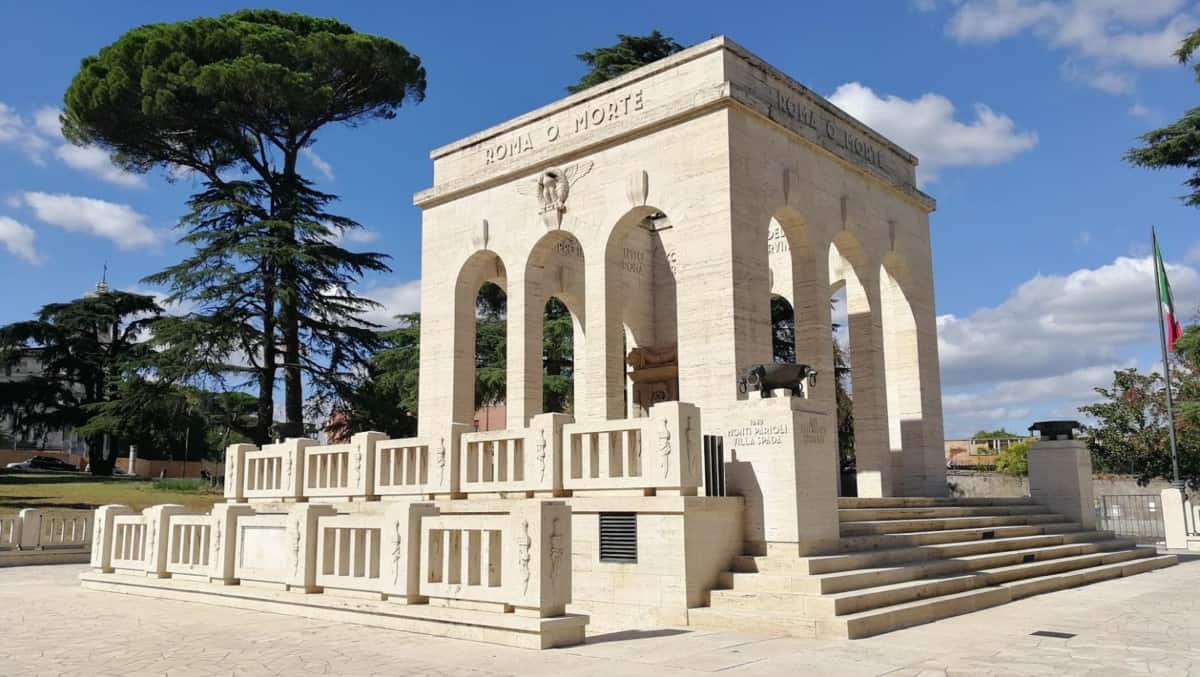
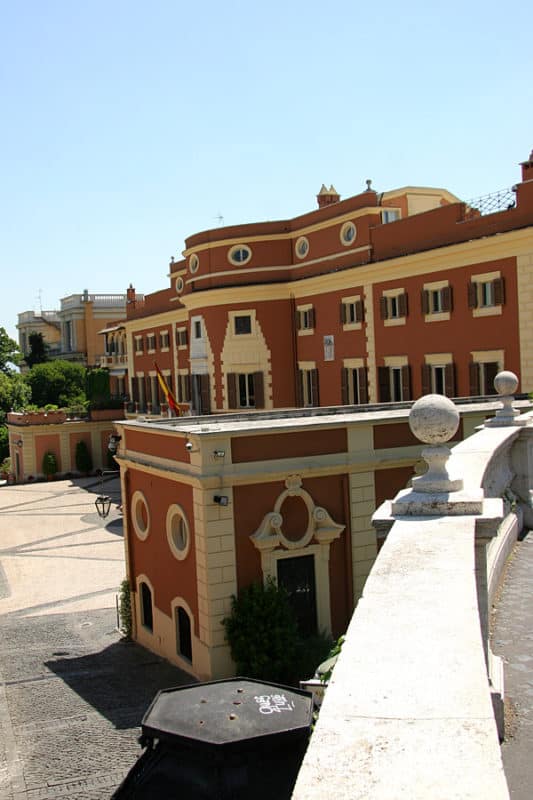
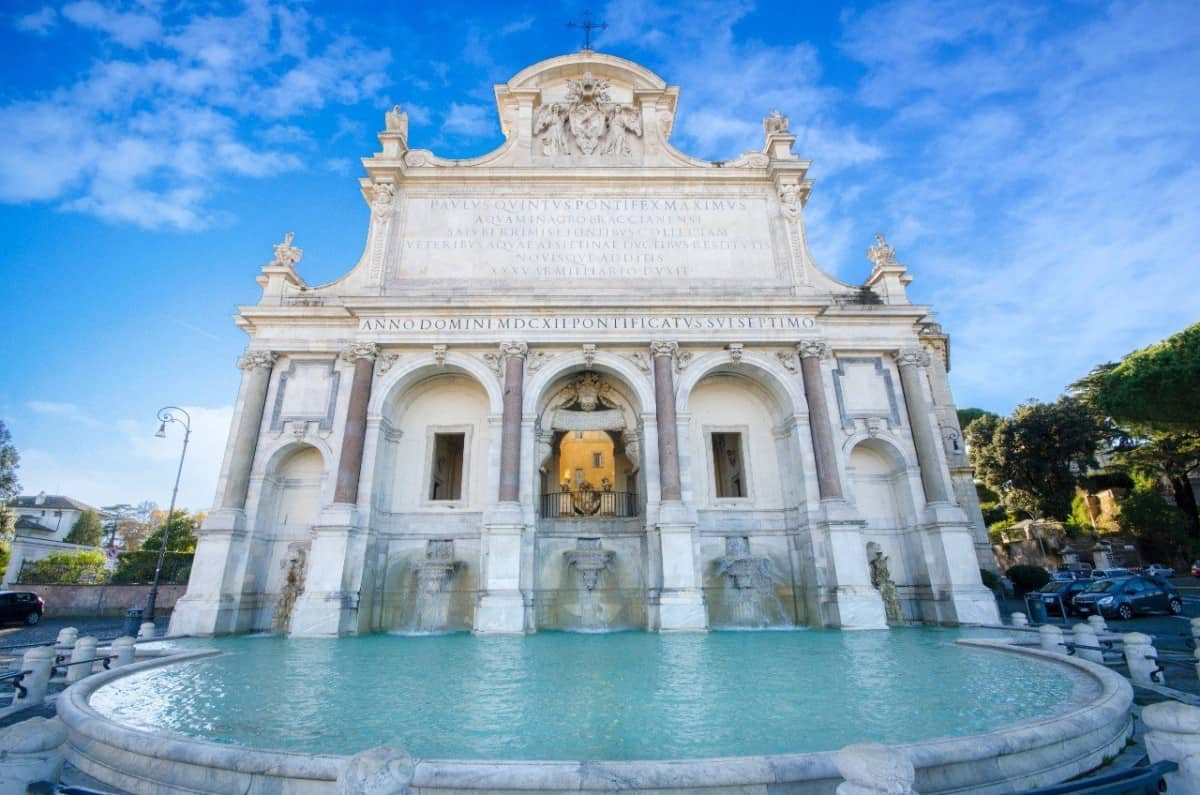
VILLA AURELIA
Let’s now walk along one of the sides of the Villa Aurelia, which rises in the same places of the famous Horti di Geta, the Caracalla’s brother who was assassinated by the latter. The Cardinal Girolamo Farnese built the palace in the 17th Century, with an architectural structure that makes it look more like a lodge than a residence. The beautiful spiral staircase of the three-storey building led to a hanging lodge with a central gallery.
The villa remained the property of the Farnese family until 1731 when, on the death of the last Duke of Parma, the Farnese possessions came to the Bourbons of Naples. From the Bourbons the villa was never used directly, but it was rented to several ambassadors, dignitaries, cardinals and, in 1774, to Count Ferdinando Giraud. In the 19th Century, the villa housed Garibaldi’s headquarters and, after a major restoration in 1880, it passed to the American billionaire Clara Jessup Heyland, who left it to the American Academy in Rome, giving it the name Villa Aurelia.
ST. PANCRATIUS’ GATE
After a few steps you reach the St. Pancratius’ Gate, which corresponds to the ancient Aurelia Gate of the Aurelian Walls. The Gate was commissioned by Pope Urban VIII, who charged the architect Marcantonio De Rossi with its construction in 1644. Damaged during the siege of Rome in 1849, it was restored after five years by Virginio Vespignani.
On the attic, among other writings, you can read an inscription that states that the door was rebuilt by Pope Pius IX, along with a room to accommodate the guards and another room to claim customs duties. Since 1948, the St. Pancratius’ Gate houses the Garibaldine Museum.
THE “HOUSE OF MICHELANGELO”
A few steps away from the Gate, in the forties of the 20th Century, was reassembled by the architect Adoldo Pernier the prospectus of the so-called House of Michelangelo (once in Via delle Tre Pile). It is not the whole building, but only a secondary façade, considering that Michelangelo Buonarroti lived and died in 1564 in a rather modest house, in an area nicknamed Macel de’ Corvi, behind the Bolognetti Torlonia Palace, destroyed at the end of the XIX Century to make space to the Victorian.
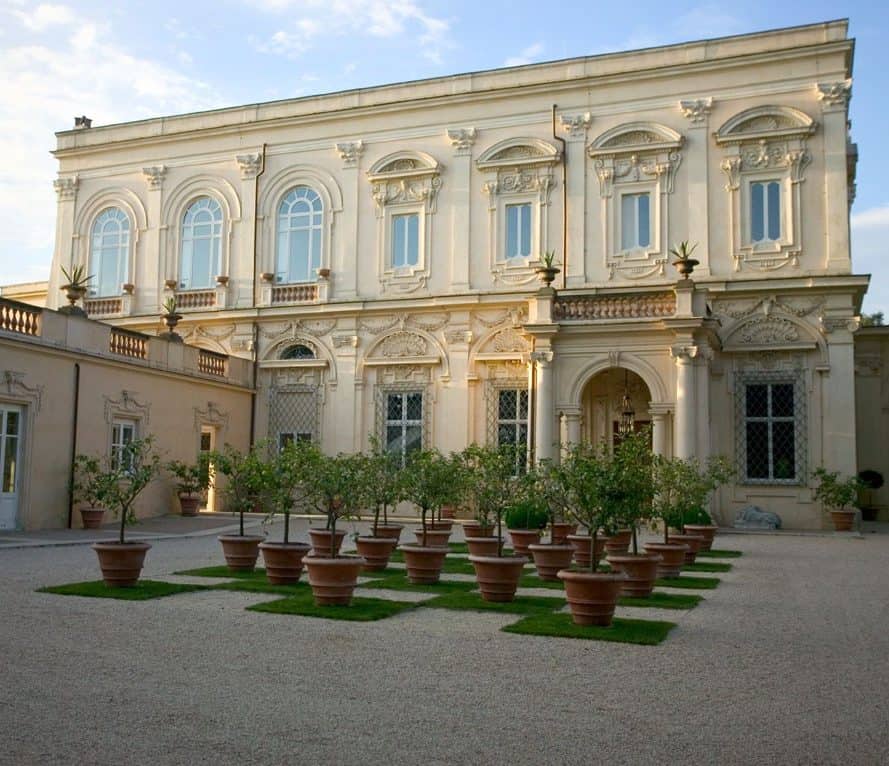
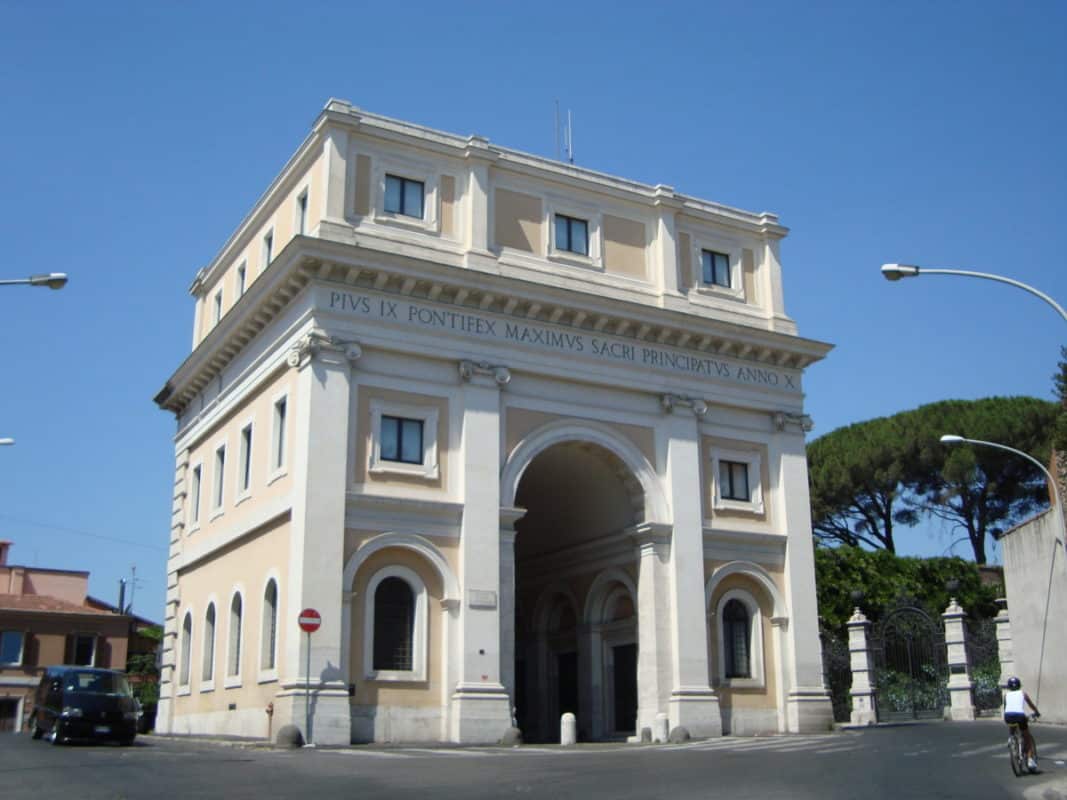
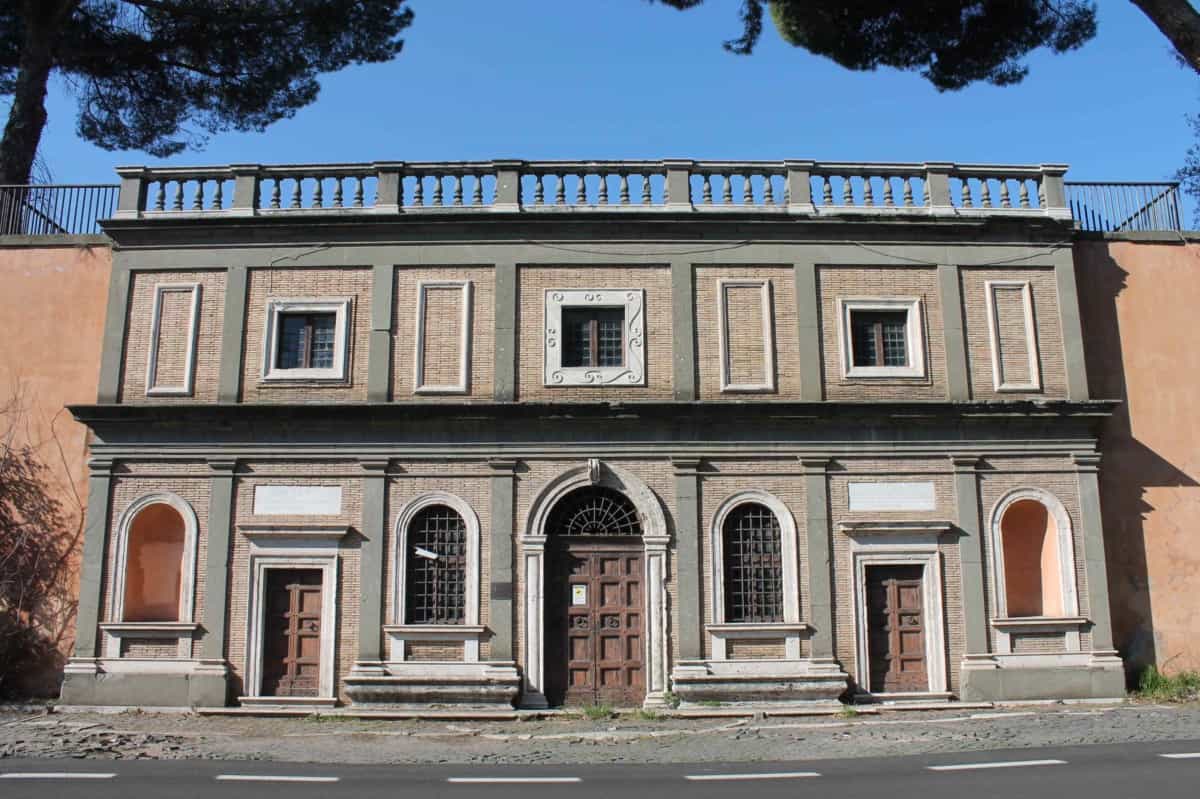
THE JANICULUM PROMENADE
Returning next to the Villa Aurelia, take the long street called Janiculum Promenade, a beautiful tree-lined avenue around which are arranged busts of volunteers of the Risorgimento, until you reach the square dominated by the equestrian monument of Giuseppe Garibaldi, by Emilio Gallori in 1895. On the pedestal there are four bronze reliefs: Assault on the bayonet of the Bersaglieri by Luciano Manara (on the front); America with the figures of Commerce and Industry (on the right), Europe with the allegorical figures of Genius and History (on the left); the Battle of Calatafimi (on the back).
A little further on, on a square, was erected in 1932 the equestrian monument to Anita Garibaldi, designed by Mario Rutelli: the body of the heroic wife of Garibaldi rests at the base of the monument.
THE CANNON
From the balcony of the square you can watch the traditional cannon shot (with blanks, luckily!) that announces noon. The tradition of the cannon shot dates back to Pius IX who, in order to avoid time confusions, instituted this service in 1846. Before arriving at the Janiculum, the cannon fired from the towers of the St. Angel’s Castle and then from Monte Mario.
VILLA LANTE
At number 10, you can admire the 16th Century Villa Lante, a precious example of the work of Raphael’s school in Rome. Baldassarre Turini, patron and friend of Raphael, entrusted the construction of the building in 1518 to Giulio Romano, who finished it in 1531. From the Turini family it passed to the Lante family, which, however, at the beginning of the 19th Century suffered a serious economic crisis: the family sold most of its vast estate and in 1817 the Villa Lante passed to Prince Camillo Borghese, the husband of Napoleon’s sister, Pauline. However, the Borghese family had no particular interest in the villa, so it was sold and bought several times, until in 1887 the famous German archaeologist Wolfgang Lante bought it.
Inside the villa there are still beautiful decorations, such as the high reliefs by Antonio Canova, while the frescoes by Polidoro da Caravaggio depicting the Meeting of Jupiter and Saturn and The discovery of the sarcophagi of Numa Pompilio were detached and reassembled in the Zuccari Palace.
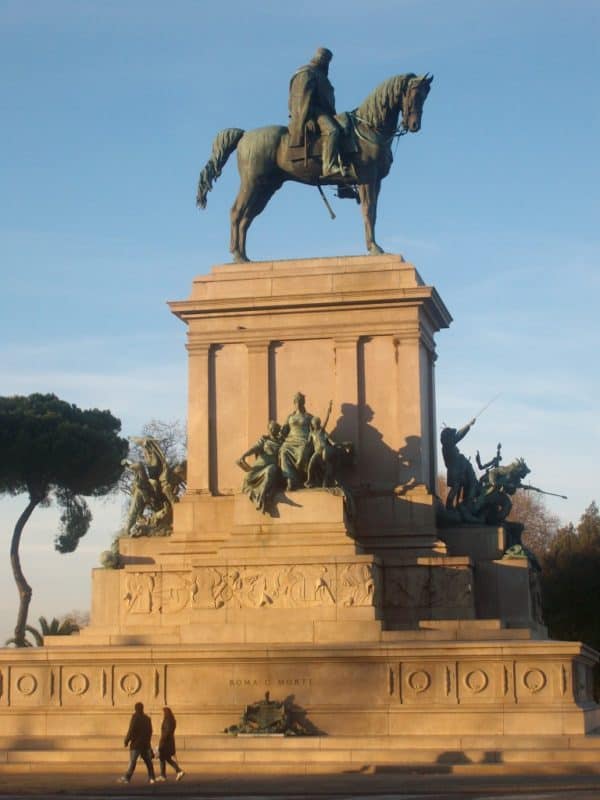
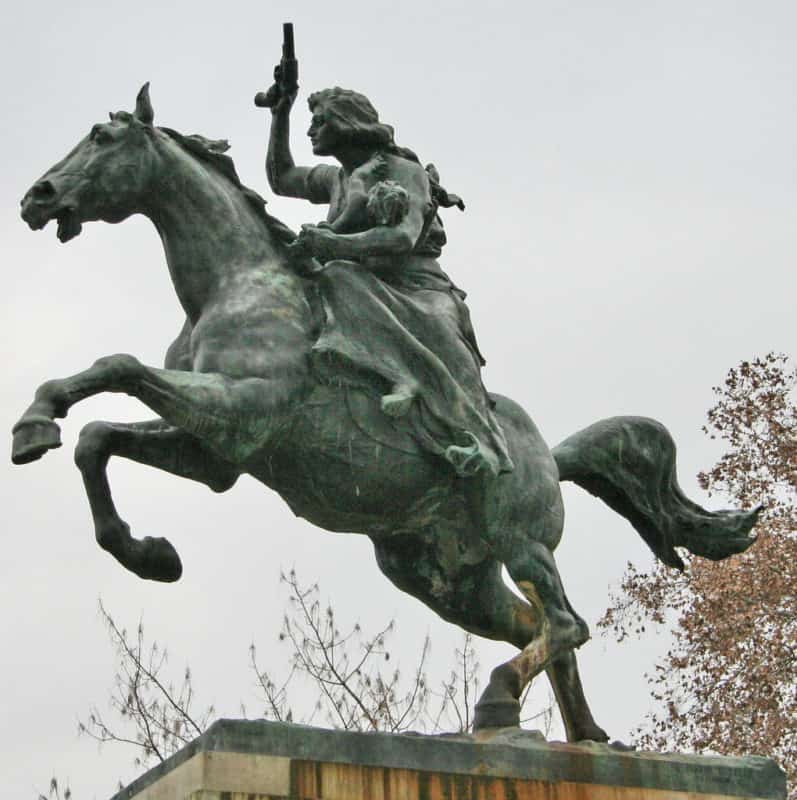
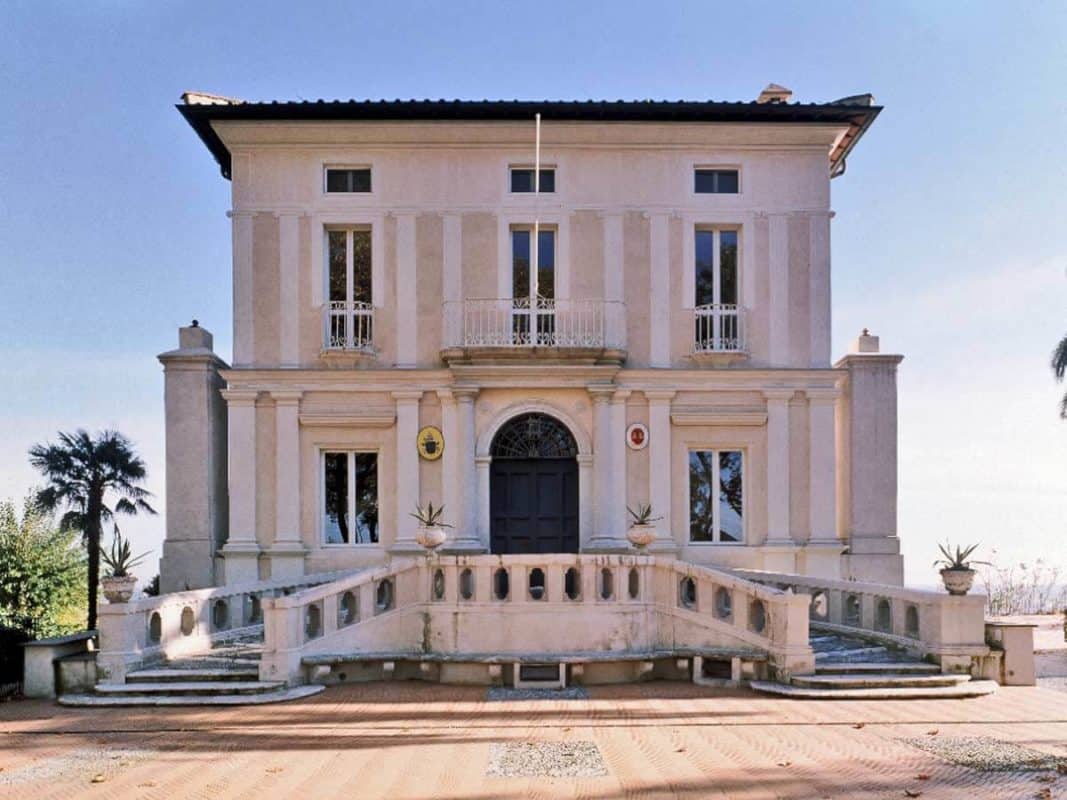
THE JANICULUM LIGHTHOUSE
Continue along the Janiculum Promenade, passing the folkloristic Lighthouse, designed by Manfredo Manfredi and donated to Rome in 1911 by the Italians of Argentina. Its tricolor beams of light remind us night and day of the patriots who, with love of country and heroism, sacrificed themselves for a free and independent Italy.
THE TASSO’S OAK
The Janiculum Promenade now takes the shape of an S, the initial part of which touches the famous Torquato Tasso’s Oak: struck by lightning in 1843, it is now a poor skeleton of withered branches supported by iron rings. In its shade, according to tradition, the poet of the “Jerusalem Delivered” used to sit in 1595, sad and lonely, thinking about the poet’s crown that he could not receive because of his illness that kept him in a state of extreme prostration.
The same tree offered its coolness to St. Philip Neri, who by a strange coincidence died in the same year of Tasso and here he came with his students to instruct them in the art of music and in the love of God. A plaque is placed in memory of both.
A little further on you will see a small hemicycle with steps, similar to a small amphitheater shaded by pine trees: built in 1619 by Marsilio Onorati, in its interior lectures, lessons and recitations of poetry have been held for over three centuries. For this reason, next to it, in 1928 an allegorical fountain was placed with the sword (symbol of the muse Melpomene) and the lyre (musical instrument symbol of the muse Tersicore) as decorations.
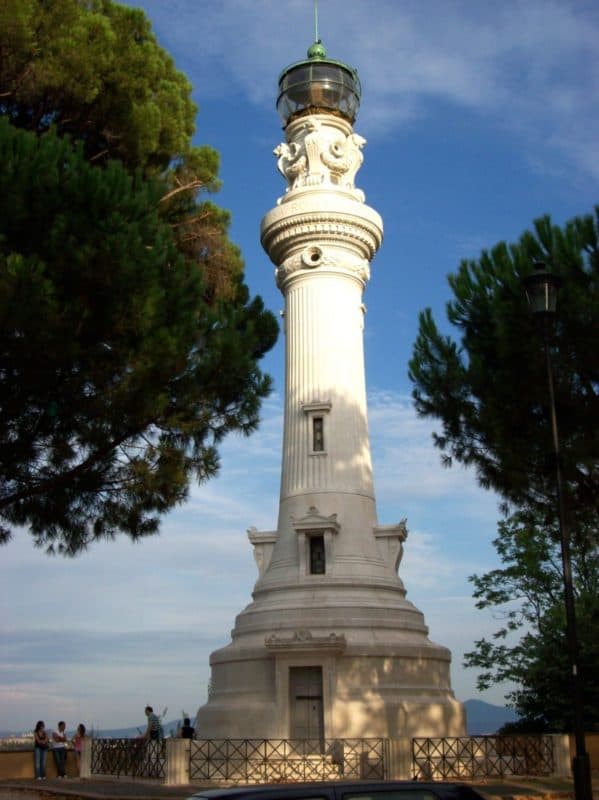
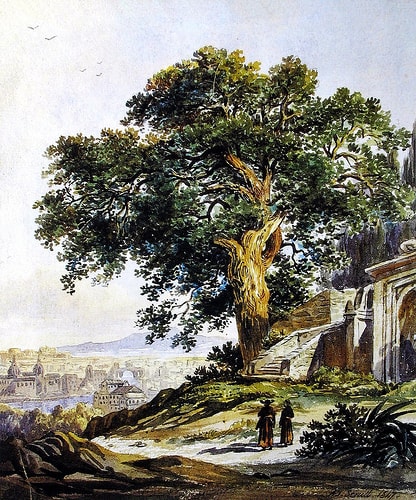
THE CHURCH OF ST. ONOPHRIUS
Continue along the Janiculum Promenade, arriving at the Square of St. Onophrius where the homonymous church overlooks the convent: they are a structure built in the 16th Century on a previous monastery dedicated to St. Jerome.
Through the portico, you can access first the cloister and then the inside of the church, begun in 1439 and completed in the 16th Century. At the beginning of the 17th Century, Cavalier d’Arpino painted Episodes of the Life of St. Onophrius in the lunettes of the cloister.
THE INTERIOR OF THE CHURCH
The interior of the church has a single nave, whose floor is strewn with tombstones. In spite of a ceiling devoid of decorations, in the gallery there are frescoes of the first half of the 16th Century attributed to Baldassarre Peruzzi and Pinturicchio representing the Madonna and Child Enthroned and Saints, the Oration of the Magi and the Flight into Egypt. The most precious treasure of the church is in the oldest Gothic Chapel, the first on the right, dedicated to St. Onophrius: during the restoration of the 20th Century, indeed, an admirable fresco painted in the 15th Century by Antoniazzo Romano and depicting the Annunciation was discovered.
In the atrium of the Chapel of St. Jerome there is the funerary monument of Torquato Tasso, realized in 1875 by Giuseppe de Fabris. In the last months of his life, Torquato Tasso asked and received hospitality in the convent: the rooms in which the poet lived have been turned into a museum, where the funeral mask and the coffin in which his body was laid, as well as a series of personal objects and manuscripts of Tasso are preserved.
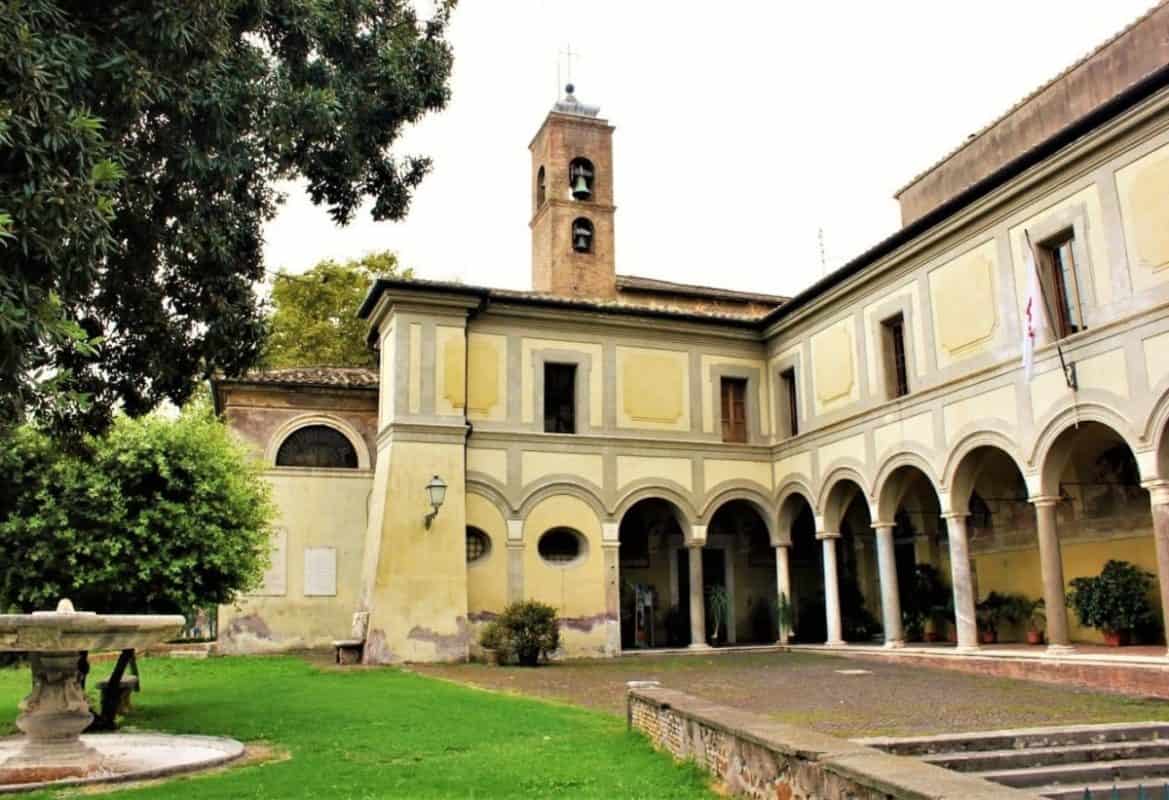
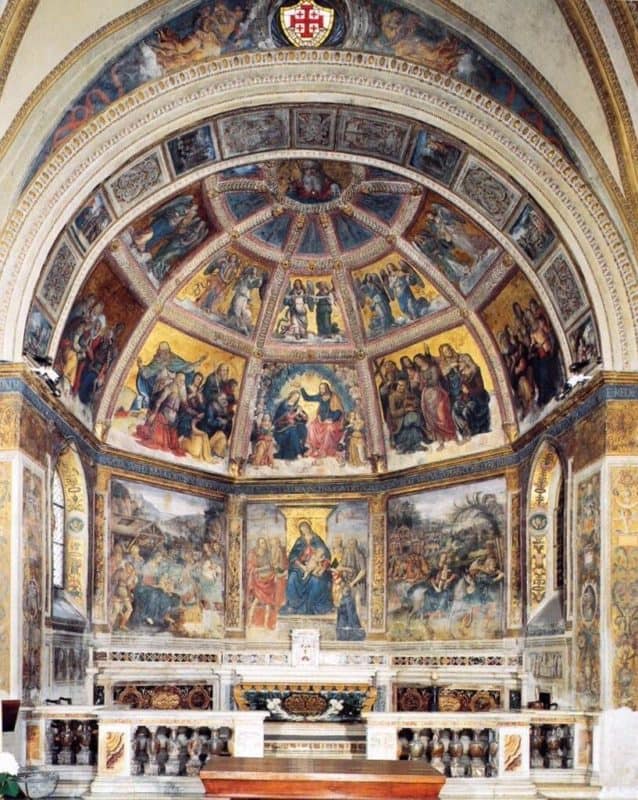
The Hospital of the Baby Jesus, created in 1869 by the Dukes Salviati, is located a short distance from the Church of St. Onophrius.
Continuing down the street, at number 14 is the Pontifical North American College, founded by Pius IX in 1859 but moved to this location only in 1953, with the purpose of training and educating Catholic priests. If open, you can also visit the small adjacent chapel, dedicated to the Immaculate Conception of the Virgin Mary and decorated with fine works by Giacomo Persichetti and Giorgio Quaroni.
THE INSTITUTE OF ST. DOROTEA
The most important structure of the final part of the itinerary, from a historical and social point of view, is undoubtedly the General House of the Institute of St. Dorotea, located at number 8 of the St. Onophrius’ Climb. It is a 17th Century building created by unifying three distinct 16th Century buildings named after their respective ancient owners: the Giori Palace, the Borromeo Palace and the Bonelli Palace.
The Giori Palace is the biggest and derives its name from the cardinal Angelo Giori (1586-1662) who was its first owner: under the cornice you can see the heraldic coat of arms of his family, composed by three bees enclosed between laurel leaves and doves, resting on three mountains and with a laurel branch in their beaks. The building was sold in 1733 to the Conservatory of St. Mary of the Refuge, which bought it thanks to the generosity of Prince Giovanni Battista Pamphilj; a Carmelite monastery was then founded to accommodate the young women of the Conservatory wishing to become nuns, which soon extended to the other two adjacent buildings. The Borromeo Palace is slightly lower than the previous one and takes its name from Cardinal Federico Borromeo (1564-1631), while the Bonelli Palace takes its name from the Bonelli Dukes who lived there since 1636. In 1844, by order of Pope Gregory XVI, all the buildings were given to the Blessed Paola Frassinetti, who founded the General House of the Institute of St. Dorotea, with an orphanage and a boarding school for girls.
From an artistic point of view, the most important rooms are the Chapel of the Immaculate Conception (1855) where Pietro Gagliardi painted the Glory of St. Dorotea on the vault and the study of the Blessed Frassinetti, furnished with valuable 17th Century paintings.
